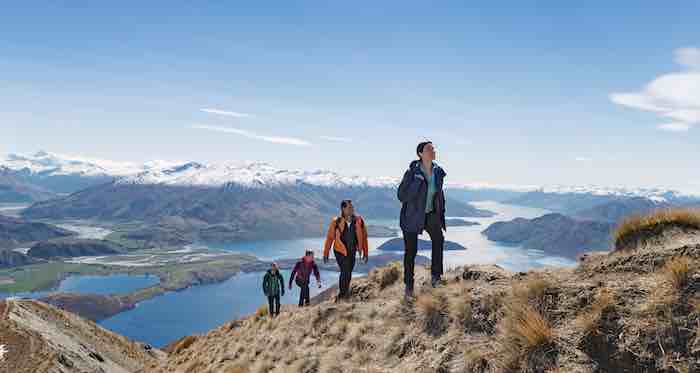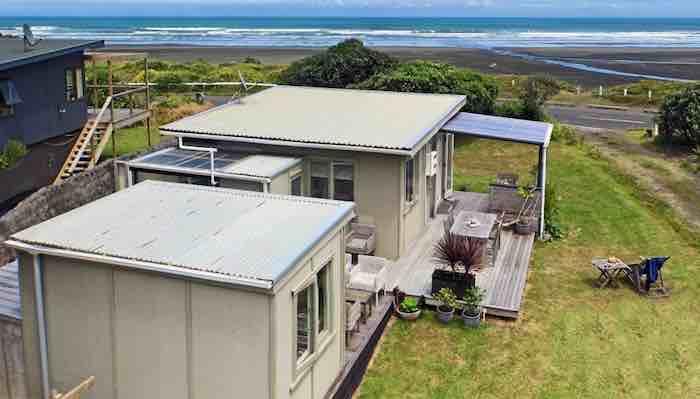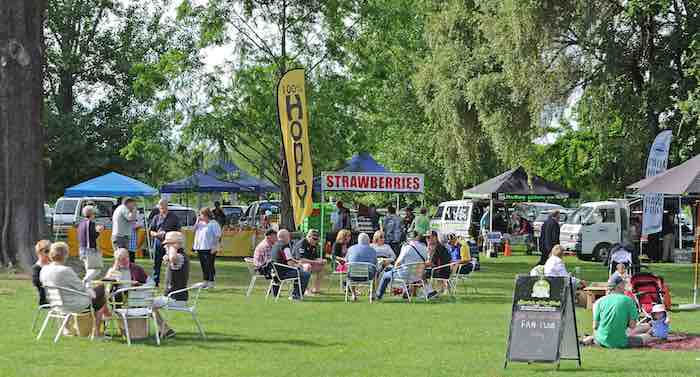Affordable New Zealand

With a little know-how and going into shoulder season (September, October, November, March, April and May), you can be budget-friendly in New Zealand.
Finding your way around New Zealand is easy, people are friendly and helpful, local produce is plentiful and reasonably priced, and it’s possible to enjoy million-dollar scenery for no cost at all. And New Zealand is great for solo female travellers since it’s so welcoming and safe!
There are also many activities that come without a price tag such as: lying on a remote beach, walking tracks and trails through unspoilt wilderness or lush native forest, body surfing, swimming in a clean fresh lake, watching abundant wildlife in natural surroundings, enjoying an outdoor concert or tumbling down a pristine sand dune.
Baches and Beach Houses
Renting a privately owned holiday home (known as a “bach” in the North Island, or “crib” in the South Island) is a good way to be self-sufficient and to get into the Kiwi way of life. The country’s largest holiday home business, Bachcare, has more than 900 holiday homes on its books, covering popular regions. Depending on location and type of accommodation, a holiday house capable of sleeping eight people and just a two-minute walk from the beach could cost about $200 NZD per night.
Apartments
New Zealand’s contemporary serviced apartments are also a good value for the savvy traveller. A spacious two-bedroom apartment, complete with kitchen and laundry facilities, can be secured for as little as $60 NZD per person per night. Many have flat-screen TVs, good sound systems and the latest kitchen gadgets. They’re also often in idyllic locations, so they offer a better than “home away from home” accommodation option. It’s also possible to book apartments for one night only through companies like New Zealand Apartments.
Backpackers and Flashpackers
Whether you're carrying a pack or pulling a suitcase, there’s no need to pay top hotel prices for good, clean, affordable accommodation in New Zealand.
Backpacker hostels can be found in almost every town and city, and range from a shared dormitory experience for as little as $15 NZD a night to a more sophisticated stay in a “flashpacker” lodge or VIP backpacker resort. More upmarket flashpacker lodges have a higher level of comfort and are likely to cost around $60 NZD a night for a double room with ensuite.
Facilities in hostels or lodges vary as much as the locations – some are beachside, peaceful and remote; others are vibrant and lively, offering a great social experience. Age is no barrier (more than 10% of people staying in backpacker hostels in New Zealand are over 40) and many places have family rooms – making hostels a fun and friendly option for families and friends.
You do not have to be a member to stay at any of the hostels and some provide free linen and blankets. Hostel managers are well-versed in local knowledge, which is a useful resource if you want to know things to do off the beaten track or cheap places to eat, shop and visit.

Self-Drive
New Zealand is an easy place to get around under your own steam and heading into the rural areas can be a cheaper option than a city stay. Farmstays and B&Bs are dotted throughout the country, and coastal areas are well-served with budget accommodation. Many visitors are pleasantly surprised that rates are quoted per room, not per person.
Motels also offer great value for your money – you can drive to the front door of a unit that is basically set up as a mini-home. Many can sleep up to six people and are fully self-catering (there’s even fresh milk in the fridge and a newspaper delivered each morning in most) making motels ideal for families or groups travelling together. Most charge per unit and, depending on season rates, start at around $120 NZD per night.
Kiwi Experience
Travellers wanting independence and flexibility swear by Kiwi Experience, a transport network which links New Zealand’s scenic and adventure attractions. Driver guides, who are local characters and experienced travellers themselves, will do everything from booking your accommodation and activities to providing in-depth commentary, entertainment and travel advice. Kiwi Experience was set up in 1989 and has carried more than 400,000 passengers over 20 million miles – often to off-the-beaten-track locations – with a hop-on, hop-off system that provides maximum flexibility.
InterCity Coachlines
New Zealand’s main coach network also offers a cost-effective travel option and will take you just about anywhere you want to go. With 3,000 daily stops at 600 destinations all year round, the nationwide service offers good value fares with concessions for infants, children, students, backpackers and senior travellers. InterCity Coach Passes offer discounted sector travel throughout New Zealand, and a Flexi-Pass that works like a pre-paid mobile phone offers discounts as high as 40% off standard fares.

Campervans
Adopting the “house on your back” idea, campervans are one of the most popular ways to explore New Zealand. It’s possible to pick up a van on one island and drop it off on the other, saving time and increasing flexibility.
Holiday Parks
There are nearly 50 TOP 10 Holiday Parks, which meet the New Zealand standard for cleanliness and value for money. The holiday parks offer different accommodation options from motels and self-contained units through to cabins, tent and powered sites for caravans, motor homes and campervans.
Campgrounds are set in park-like settings, offering plenty of space, with children's play facilities, barbecues, and safe indoor and outdoor recreational areas. Many also have additional facilities such as tennis courts, swimming pools, spa pools and jumping pillows.
Fresh Foods
Self-catering options cut per day costs and it doesn’t take long for travellers to adopt the Kiwi way of eating simple, fresh foods based on seasonal produce. Farmers’ markets, local supermarkets and roadside stalls offer ample opportunity to buy fresh foods at reasonable prices – and some visitors even get involved in casual fruit picking for a social, outdoorsy experience and to help stretch the budget.
Hiking
Alongside New Zealand’s highly popular Great Walks network of nine multi-day trails (soon to become 10), Tourism New Zealand recently announced 14 short walks and 5-day hikes. The tracks were chosen for their beauty and variety of environments, as well as for their accessibility and good visitor facilities. Short walks (30 minutes to three hours) will appeal to those with more compact itineraries. The day hikes (three to eight hours) will encourage visitors to stay longer in a region, without the need to commit to a more full-on, multi-day trail experience.
Looking for more – there are more than 3,000 km of hiking trails in New Zealand from the tip of the North Island to the tip of the South Island.
Biking
If you are a biker, you will love New Zealand. There are 2,500 km of biking trails in the country. Bring your bike or rent one while in an area and you will see the countryside and nature – and you won’t break the bank.
Beaches
There are beautiful beaches throughout the country. Whether you are looking to swim and enjoy the beach or to rent kayaks or stand up paddleboards, the New Zealand beaches are a great way to save money and have an amazing day.
Travel New Zealand -- Bio and
Archives |
Comments
For more information on New Zealand, please visit: NewZealand.com. The site offers interactive planning tools, special travel deals, operator listings and information on New Zealand.

 With a little know-how and going into shoulder season (September, October, November, March, April and May), you can be budget-friendly in New Zealand.
Finding your way around New Zealand is easy, people are friendly and helpful, local produce is plentiful and reasonably priced, and it’s possible to enjoy million-dollar scenery for no cost at all. And New Zealand is great for solo female travellers since it’s so welcoming and safe!
There are also many activities that come without a price tag such as: lying on a remote beach, walking tracks and trails through unspoilt wilderness or lush native forest, body surfing, swimming in a clean fresh lake, watching abundant wildlife in natural surroundings, enjoying an outdoor concert or tumbling down a pristine sand dune.
With a little know-how and going into shoulder season (September, October, November, March, April and May), you can be budget-friendly in New Zealand.
Finding your way around New Zealand is easy, people are friendly and helpful, local produce is plentiful and reasonably priced, and it’s possible to enjoy million-dollar scenery for no cost at all. And New Zealand is great for solo female travellers since it’s so welcoming and safe!
There are also many activities that come without a price tag such as: lying on a remote beach, walking tracks and trails through unspoilt wilderness or lush native forest, body surfing, swimming in a clean fresh lake, watching abundant wildlife in natural surroundings, enjoying an outdoor concert or tumbling down a pristine sand dune.
